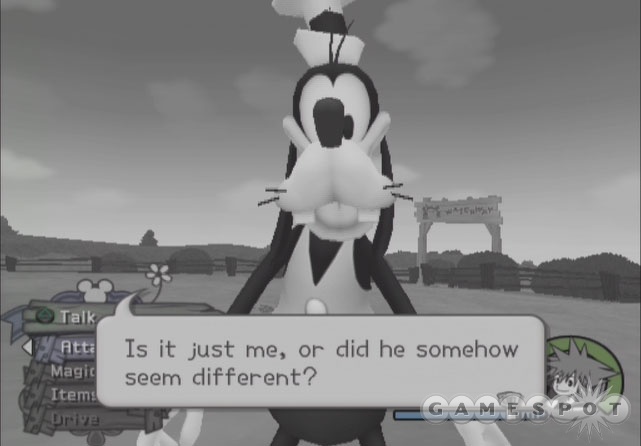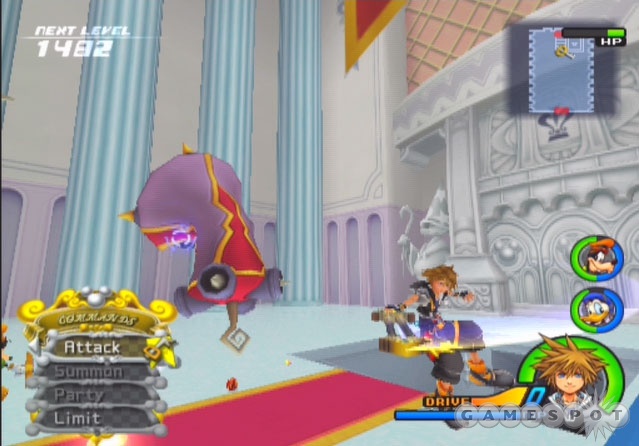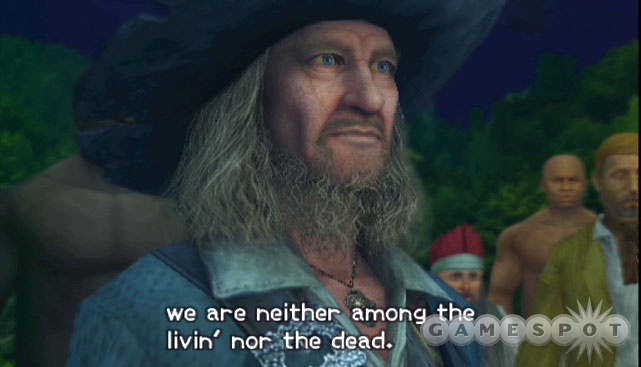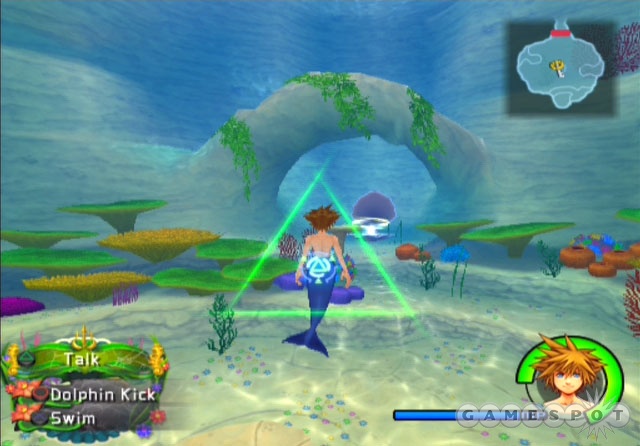Kingdom Hearts II is the long-awaited sequel to the 2002 Disney/Square collaboration Kingdom Hearts. Picking up the story where the former game--and the interim Game Boy Advance release, Kingdom Hearts: Chain of Memories--left off, Kingdom Hearts II guides you through a series of Disney-themed worlds as you encounter a cast of characters that reads straight off the credits of some of the most popular Square games and Disney movies. Though the formula in KHII is quite familiar, much of the gameplay has changed, and it's safe to say that it's been for the better. Fans of the original game and of Disney/Square properties in general will fall in love with this game quite easily, though a few problems with the basic gameplay prevent Kingdom Hearts II from being whole-heartedly recommendable to everyone else.

In KHII you reprise the role of Sora, a young boy who happens to have just the right mojo for wielding the keyblade. The keyblade is a weapon that is, aptly, useful both as a key to unlock other worlds and as a method for destroying the heartless, a species of monster that is taking over the otherwise peaceful Disney lands at the behest of Sleeping Beauty's very evil Maleficent. The crux of the game has you, Sora, traveling from one land to another with companions Donald Duck and Goofy to dispel the heartless and to rescue friends of yours that are missing. Along the way, you'll join forces with the heroes and heroines of Square, Disney, and The Nightmare Before Christmas. For people enthused with these properties, Kingdom Hearts II is a wonderful experience in which every character interaction gives you the opportunity to live through some of the magic moments of these movies and games.
As an action role-playing game, Kingdom Hearts II gives you a certain amount of freedom, both in determining your characters' attributes and in resigning yourself to standard combat. You'll be able to do a little bit of both or a lot of one or the other, depending on your preferences. Seasoned role-playing gamers will be able to spend plenty of time perfecting the allocation of their attributes (or abilities), synthesizing new items, and grinding to level up, while those less interested in the role-playing aspects can breeze through the main gameplay without paying much attention to statistics.
While the ease of gameplay customization is one of the game's greatest strengths, the ease of the game in general is surely its largest weakness. The main quest, which clocks in at over 40 hours of gameplay, is never difficult. You can get through almost the entire game without dying, save for a few challenging boss battles at the end of the game. This is an improvement upon the original Kingdom Hearts, in which the difficulty occurred in moments of backtracking, tediousness, and confusion. But because there's no difficulty of any kind (at the default difficulty setting), getting through the gameplay in Kingdom Hearts II never gives you a satisfying sense of accomplishment. The rhythm minigames found in various levels, presumably included to offer gameplay variation, are mind-numbingly easy, often requiring only one button press over and over (when prompted, no less) to get through.
The game's length and its devotion to character exposition are its saving grace. The lack of satisfaction from beating a particularly challenging gameplay segment is made up for in spades by the continually changing cast of characters and the monumental time you spend interacting with them. You don't have to be familiar with everything related to Disney, Square, or even the previous games in the series to enjoy Kingdom Hearts II, but familiarity will make the experience more enjoyable.

To that end, Square and Disney have brought on board a tremendous voice-acting cast, including the now pubescent Haley Joel Osment to reprise the role of (now pubescent) Sora, the commanding voice actor Christopher Lee, and many of the actors responsible for voicing their Disney movie counterparts, including Geoffrey Rush as Captain Barbossa from Pirates of the Caribbean, Ming Na as the voice of Mulan, James Woods as Hades, and the list goes on and on. When the actor responsible for the original Disney voice isn't used, then the actor who voiced that character in other iterations (like the television series or straight-to-video sequels) is used, and in the absence of both, the voice is still almost indiscernible from the ones you're likely familiar with. There are one or two bad apples among the bunch (like the screechy Princess Jasmine), and the Square characters didn't get quite the same treatment as the Disney characters did, but for a game with as many voices as Kingdom Hearts II, the overall quality is still excellent. Further enhancing the aural experience is the game's superb soundtrack, which consists of a fair share of original music and remixes of movie themes. Large portions of Disney songs--from The Little Mermaid, for example--make their way into the rhythm games on the Atlantica level and are in fact the minigames' redeeming quality. If you're familiar with the songs from these franchises, you'll no doubt be humming along to them in this game, a tribute to how well the music was adapted and integrated into the gameplay.
Most of the Disney worlds take you through the plot of the corresponding movies, so the immersion is enhanced by dialogue that is often taken directly from the source material. In one scene, Captain Barbossa declares to Elizabeth Swann, "You best start believin' in ghost stories. You're in one!" and then takes a swig from a bottle of wine, which you can see go all the way down his zombie-pirate chest--it's a scene that should be more than a little familiar to anyone who has even seen a trailer of Pirates of the Caribbean. The Square characters, which don't have the luxury of being a part of an established movie plot, are appropriately aloof as a result. And in one moment, formerly intimidating Final Fantasy VIII antagonist Seifer declares, "We totally owned you lamers!" which is just about as horrible as it sounds. Fortunately, there's much more Disney influence than Square, and for most of the game you'll feel like you're there participating in the plotlines of your favorite Disney movies.
Where the Square influence lies is in the Final Fantasy-style gameplay mechanics, which consist of not only melee and magic attacks, but limit breaks and summons as well. The basic combat button lets you hash out combos with the keyblade, with the occasional time-sensitive action button interspersed. As you play through the game, naturally leveling up your characters, you'll be able to allocate ability points to a number of different actions and support activities that you unlock along the way. An action might impact the way your combat works, and a support activity might make it easier for you to collect the orbs and munny (the game's currency) that spill forth from the enemies. For Sora, at least, you'll almost always have more possible abilities than points to facilitate them all, so careful selection of your abilities will allow you to create a character that is predominantly melee, magic-based, or supporting, for example. You can also change these on a whim (unless you're in combat), so you can play around with your abilities until you find the winning combination.

Limit breaks are moves made in conjunction with your other partymates, and it's the unique limits of the guest characters you team up with that make the combat diverse and interesting. The limit drains your magic power, along with your other magic spells, including cure, which uses up the entire bar, so you must carefully manage your magic among your party. Since melee combat is almost always the most effective, you'll probably just concentrate on that and throw in a limit or a cure whenever your magic bar has filled up again. As you play through the game, you'll also be able to discover summon entities. Since the summons from the previous game (Mushu and Simba) now have their own levels, you'll be working with new (and mostly useless, with the exception of the ever-adorable Stitch) summons for this game.
Also new is the concept of drives, which offer another dynamic to the gameplay and which share a meter with the summon spells so that your resources aren't spread too thin. A drive move will combine you with another character (like Voltron) so that you become a more-powerful creation with a unique move set. It's definitely neat, but it isn't enough. Despite all the cool new spells and their usefulness against some of the more-imposing enemies, you will spend the majority of the game hammering on the main attack button, not because it's the only thing you can do, but because it's the most efficient. The game's bosses, of which there are many, are all interesting and well conceived, but they rarely require a different approach than the normal enemies. This is a shame, because the latter half of the game, which consists of a great number of boss fights, would have been more interesting if the bosses had been much different from the regular gameplay.
When you're not fighting, you're traveling from one area to another. The worlds you explore are all extremely linear, much more so than those in the last Kingdom Hearts game, and you'll find it almost impossible to get lost. The levels aren't that large--most of them consist of no more than 10 different locations--but the frequency of cinematics and timed fights makes each level take a couple of hours. Plus, there's always plenty of hidden stuff to collect from the many chests peppered throughout the game, so you can keep busy within those small environments. To travel between the worlds, you must make use of the gummi ship, which was one of the weakest gameplay components in the original Kingdom Hearts. The gummi ship levels have greatly improved, but they still consist of the same on-rails flight shooting. There's a reason to replay the gummi ship areas--either to collect treasure or to just play around with the rich create-a-ship builder--but as with the first game, there's something distinctly unimpressive about the gummi ship levels, and it's likely that after you play through each level once, thereby unlocking it, you won't find reason to go through again.

The regular worlds that you travel to are much more compelling than the gummi ship worlds, both in features and in appearance. Each one is perfectly themed to its source movie, all the way down to the heads-up display that you see on the screen. Though the graphics might not be the best seen to date on the PlayStation 2, their variety, and the exactness with which each one is executed, makes the game visually impressive all the same. Considering that you're often going from tightly knit environments to sprawling boss battles against giant foes, there's a great range to the game's appearance, making it, at the very least, always interesting to look at.
Kingdom Hearts II has made some big steps in the four years since the original Kingdom Hearts game was released. Significant changes to both the camera system and the basic combat allow you to play through the game without being frustrated by either, and the gameplay is, for the most part, either enjoyable or inconsequential. The game offers an extremely long gameplay experience that takes you through an absolute whirlwind of Disney and Square franchises, letting you interact with virtually every character you could conceive of joining up forces with or fighting against. This is effectively an ode to its source material, and to that end, Kingdom Hearts II does not disappoint. Yet there's still something about Kingdom Hearts II that doesn't make it universally appealing. The mechanics are secondary to the story and the experience, and you'll find yourself often mashing your way through the easy gameplay in an effort to witness more of the game. Though the fusion of Square and Disney--which at one time might have been thought a surprising combination--has once again been successful in Kingdom Hearts II, the fusion of the concept and the gameplay falls a tiny bit short of being everything you'd hope for in a Kingdom Hearts sequel. Nevertheless, there's enough to the game both in depth and in story to make it entertaining for a long time.



